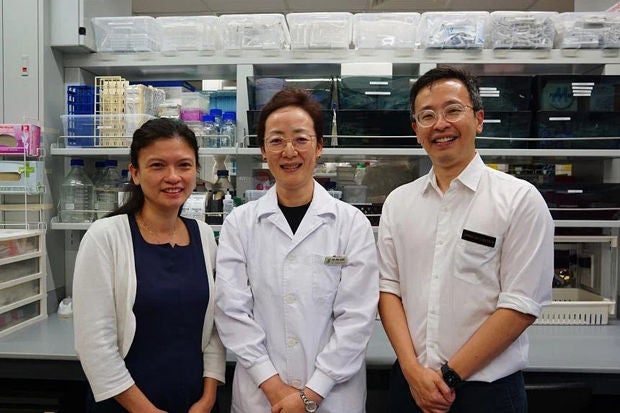
(From left) Associate Professor Andrea Low, Dr Fan Xiubo and Associate Professor Ng Chin Teck are part of the SGH research team which found that restoring the balance of a protein in blood could help in the treatment of lupus. PHOTO: SINGAPORE GENERAL HOSPITAL
SINGAPORE - Restoring the levels of a certain protein found in blood could prove to be an effective treatment for lupus, researchers at the Singapore General Hospital (SGH) have found.
The researchers found that the levels of the protein CXCL5 in the blood of patients with the autoimmune disease were significantly lower than in healthy individuals.
This suggests that low levels of CXCL5 – which helps regulate the immune system through neutrophils, a type of white blood cell – may be a reason for lupus activity, SGH said, adding that similar results were found in mice with lupus.
Lupus – or systemic lupus erythematosus – is an autoimmune disease where the body’s immune system attacks its own tissues and organs. It is potentially life-threatening as it affects major organs such as the kidneys, heart and brain.
Worldwide, lupus affects about 100 in every 100,000 people. Among those with the condition is American singer-actress Selena Gomez.
The condition is more severe in Asians, and most commonly affects women between the ages of 15 and 45.
While there is currently no cure for lupus, the condition can be controlled with medications such as steroids, antimalarial drugs and immunosuppressants, said Dr Fan Xiubo, senior research fellow with the SGH’s department of clinical translational research.
However, between 30 per cent and 60 per cent of lupus patients do not respond to existing treatments, said Dr Fan, who is also the study’s principal investigator.
This is especially so for those with more severe disease involving the kidneys, she noted. “There, therefore, remains a need for better treatments, especially for the more severe forms of lupus.”
The researchers found weekly injections of CXCL5 to mice with severe lupus restored balance of the protein, resulting in their survival rates increasing from 25 per cent to over 70 per cent at 10 weeks.
These mice also saw improved kidney function and reduced lupus activity compared with those treated with saline.
When CXCL5 was given together with cyclophosphamide – a conventional treatment for lupus – the protein seemed to prevent the toxic side effects of cyclophosphamide.
This enabled the mice to survive for up to two years.
“Our study has shown CXCL5 to be safe. There was no liver or kidney toxicity or cancer-inducing effects. Major components of the immune system were also not compromised,” Dr Fan said.
The study findings were published in November in peer-reviewed journal Arthritis & Rheumatology, and highlighted as an important study in Nature Reviews Rheumatology that month.
Healthcare cluster SingHealth, which runs SGH, filed a patent covering the results of the study, which has been granted in the United States and Singapore.
The next step is to undertake “appropriate studies” in preparation for Phase I and Phase II clinical trials in lupus patients, said Associate Professor Andrea Low, head and senior consultant in the department of rheumatology and immunology at SGH.
“We are looking for industry partners to take this forward to translate the discovery and bring this to clinical trials in the coming two to three years to benefit lupus patients,” added Prof Low, a senior author of the study.
Contributed by














 Get it on Google Play
Get it on Google Play